ERA Country Report 2023
Ireland
Edited by Andrew Murphy (CARSA)
as part of ‘Development of the ERA Scoreboard, the ERA Dashboard and the Regular Reports’ project for the European Commission, Directorate-General for Research and Innovation under Framework Contract N° 2018/RTD/A2/OP/PP-07001-2018 Lot 2 (EDAR)
Click here to download this country report![]()
- Table of contents
-
ERA Country Report 2023: Ireland
1. National context
1.1. Overview of the ERA policy agenda implementation
1.2. Policy context
2. Assessment of the Implementation of the ERA Policy Agenda and ERA Priorities
2.1. ERA Priority 1: Deepening a truly functional internal market for knowledge
2.2. ERA Priority 2: Taking up together the challenges posed by the twin green and digital transition and increasing society’s participation in the ERA
2.3. ERA Priority 3: Amplifying access to research and innovation excellence across the Union
2.4. ERA Priority 4: Advancing concerted research and innovation investments and reforms
3. Country-specific drivers and barriers
4. Final remarks
5. Bibliography
6. Annexes
6.1. Annex 1: Graphs
ERA Country Report 2023: Ireland
|
Key takeaways:
|
1. National context
1.1. Overview of the ERA policy agenda implementation
Ireland performs above average in the European Innovation Scoreboard (EIS) 2023 and has been determined as a Strong Innovator, as its performance is 111.5% of the EU average. Ireland has committed to ten ERA actions across three of the four priorities of the ERA Policy Agenda ^ The ERA actions Ireland committed to are those that are most closely aligned with the national priorities agreed in Impact 2030, which was published in May 2022.
The country’s national strategy is Impact 2030, Ireland’s Research and Innovation Strategy, launched on 18 May 2022. It aims to place research and innovation at the centre of tackling Ireland’s social, economic and environmental issues. The First Annual Progress Report for Impact 2030 was published in July 2023 and reports that 29 out of 30 of the strategy’s flagship initiatives have been delivered or have progressed well. The Progress Report also details that Ireland’s R&I system is having sustained impact on critical areas such as the green transition and the digital transformation through key initiatives such as the EUR 65 million National Challenges Fund and collaborations between industry and academia, allowing for research commercialisation and innovation throughout the country. Furthermore, there have been significant legislative changes, namely the Higher Education Authority Act 2022 and amendments to the Finance Act 2022, specifically related to R&D tax credits in order to align Ireland with international standards.
One of the priority actions in Impact 2030 is the establishment of a new competitive R&I funding agency. The amalgamation of SFI and the IRC will improve the coordination of funding activities, administrative efficiencies and simplify the suite of supports for researchers, while building on both funders’ respective existing track records and international reputations.
The Research and Innovation Bill, which was published on the 8 January 2024, provides for the creation of the new R&I funding agency, Taighde Éireann and the objects and functions of the new agency. The Bill also contains provisions to dissolve SFI, and for the transfer of staff, records, assets and liabilities of staff from SFI.
The White Paper on Enterprise 2022-2030 sets out the Government’s enterprise and industrial policy priorities and incorporates enterprise innovation as a strategically important goal. Ireland also has the Whole of Government Circular Economy Strategy 2022-2023 “Living More, Using Less” with implications for the R&I sector. Ireland has put in place priorities and instruments focused on digital infrastructure and skills, with the aim of improving the productivity of small and medium enterprises (SMEs) in particular. In 2022 DETE launched Ireland’s National Smart Specialisation Strategy.
1.2. Policy context
The main government body responsible for the development and implementation of R&I policies is DFHERIS. Within the institution, the main agencies include the Higher Education Authority (HEA), the Irish Research Council (IRC) and Science Foundation of Ireland (SFI). The Higher Education Authority funds research directly though designated higher education institutions and in line with the HEA Act 2022 progresses research policy, culture and the research environment. Science Foundation Ireland’s current strategy sets out its approach to developing excellence in the country’s research base and incentivising Ireland’s advantage in emerging fields of research.
The Department of Enterprise, Trade and Employment (DETE) and its agencies have developed strategies that align with and support the ERA Policy Agenda including the National Smart Specialisation Strategy, an innovation policy to boost regional innovation ecosystems contributing to growth. In addition, the White Paper on Enterprise 2022-2030 sets new goals for enterprise innovation. DETE also oversees enterprise innovation policies and coordinates the activities of the enterprise development agencies and their programmes, with a special focus on supporting innovative start-ups and bolstering collaboration between industry and academic research. ^ DETE’s agencies include Enterprise Ireland (EI), IDA Ireland (Ireland’s Foreign Direct Investment Agency), InterTradeIreland and the National Standards Authority of Ireland. EI and IDA corporate strategies place research and innovation at their core, in the context of the ongoing green and digital transitions.
The Department of Environment, Climate and Communications (DECC) has responsibility for the areas of environment, climate, communications, cyber security and energy. The Geological Survey Ireland and the National Cyber Security Centre are part of DECC. Agencies with a role in research and innovation include the Environmental Protection Agency, the Sustainable Energy Authority of Ireland, and Inland Fisheries Ireland. In addition to their in-house scientific, research and evidence capability, several of these organisations provide competitive research and innovation funding. Many strategies and policies led by DECC include aims and objectives relating to research and innovation in thematic areas. These include the Mid-Term Review of the National Cyber Security Strategy, the Climate Action Plan 2023, and the National Hydrogen Strategy.
The Department of Agriculture, Food and the Marine and its agencies the Marine Institute and Teagasc support and fund R&I in their areas of responsibility. The Department of Health and its agency the Health Research Board support and fund health related R&I, have presented maximum levels of public investment in research and development from 2020 to 2023.
Impact 2030 is a government strategy framed around five pillars which closely align with the objective of the ERA policy agenda. These pillars are: (1) Maximising the Impact of Research and Innovation on Our Economy, Society, and the Environment, (2) Impact of Research and Innovation Structures on Excellence and Outcomes, (3) Innovation Driving Enterprise Success, (4) Talent at the Heart of the Research and Innovation Ecosystem and (5) All-Island, EU and Global Connectivity. Through these pillars, the strategy aims to maximise the impact of R&I for addressing economic, social, and environmental issues, while promoting talent and engagement with science. ^ In solidarity with the ERA Policy Agenda, Ireland aims to bolster research infrastructure and culture through universities and technological institutions, and ensure innovation reaches its highest potential through strengthened collaboration with businesses.
Ireland’s R&I system has been transformed since the start of this century, with total Government investment in R&I increasing from less than EUR 250 million to EUR 964 million in 2022. It is estimated to reach EUR 1.075 billion in 2023, the first time it will surpass the one billion Euro mark. ^
Total R&I investment (public and private) increased from EUR 2.8 billion in 2012 to EUR 4.9 billion in 2022 (latest data available), the highest level ever recorded. The business sector accounts for approximately 80% of R&I investment in Ireland – the contribution of the business sector is also strong in the US, at over 70%.
In spite of the significant increase in value of public and private expenditure on R&I, it is challenging to reach our research intensity targets. This is related, at least in part, to Ireland’s economic growth, which has increased at a rate well above the EU average.
Impact 2030 commits to a research intensity target of 2.5% of GNI* by 2030. The modified GNI aggregate is regarded as a better approximation of the size of the Irish economy. The intensity rate was 1.78% in 2022 down from 2.0% of GNI* in 2021. This compares to the EU average of 2.2% of GDP.
2. Assessment of the Implementation of the ERA Policy Agenda and ERA Priorities
Chapter 2 has two objectives: 1) It qualitatively assesses the state-of-play of the implementation of the ERA actions that Ireland has committed to. The assessment builds on information collected through desk research (Country Reports from the European Semester, European Innovation Scoreboard, Irish government resources) and the OECD STIP Survey 2023; 2) It quantitatively assesses the country’s progress towards achieving the ERA priorities as set out on the Pact for Research and Innovation in Europe. While the implementation of the ERA Actions should support achieving the ERA Priorities, the method currently does not allow to directly assess the impact of the ERA Actions on the ERA Priorities.
The presented quantitative information is mainly based on the ERA Scoreboard and ERA Dashboard indicators and covers longer-term trends since 2010. Additionally, general indicators for the overall R&I system are outlined in Table 1. More detailed information on the data and graphs can be found in Annex 1. This report will serve as a baseline for reporting in the future.
|
Indicator |
Most recent EU average |
Most Recent Metric |
|
Gross Domestic Expenditure on R&D (GERD) as a percentage of GDP |
2.26 (2021) |
1.06 (2021) |
|
Government Budget Allocations for R&D (GBARD) as a share of GDP |
0.76 (2021) |
0.22 (2021) |
|
Researchers (in full-time equivalent) per million inhabitants |
4.483,4 (2021) |
4,592.6 (2021) |
|
Business Enterprise expenditure on R&D (BERD) as a percentage of GDP |
1.49 (2021) |
0.8 (2021) |
Source: compiled by research team based on the ERA Scoreboard and ERA Dashboard indicators
2.1. ERA Priority 1: Deepening a truly functional internal market for knowledge
2.1.1. State of play in the implementation of the ERA Actions
Ireland has committed to ERA Action 1: Enable the open sharing of knowledge and the re-use of research outputs, including through the development of the European Open Science Cloud (EOSC). In November 2022, Ireland published a new national action plan on open research, which identifies a number of priority areas to progress Ireland’s journey towards open science and contribute to the implementation of this ERA action. Additionally, the National Open Research Forum (NORF) was established in 2017 and since 2022 has delivered an Open Research Fund provided by the HEA which supports the implementation of the Action Plan. NORF’s Open Research Fund has been created to intensify the diffusion of open science practices across Ireland. In 2022, 6 projects received a total of EUR 1.16 million to build national capacity and infrastructure for open research and in 2023 a further EUR 1.9 million was provided to support an additional 13 projects. ^ Open Science infrastructure has been supported through the Irish Research eLibrary (IReL. and funded through DFHERIS and the HEA. ^ The Digital Repository of Ireland (DRI) is also trusted digital repository that provides long-term preservation and access to Ireland’s humanities, cultural heritage, and social sciences digital data and which is open for use by researchers in these areas in higher education institutions ^.
Ireland is part of the EOSC’s tripartite collaboration consisting of the Commission, Member States and EOSC Association, and has developed the National Framework on the Transition to an Open Research Environment 2019 and the National Action Plan for Open Research 2022 which focuses on the strategic areas of open access to research publications and dedication to findable, accessible, interoperable and reusable (FAIR) research data. ^ According to the EOSC Survey 2021, Ireland’s Framework has concrete objectives related to EOSC and addresses the preservation and reuse of scientific information, addresses infrastructures that include aspects of open science, incentives, competencies and rewards and has associated financial planning.
Ireland has committed to ERA Action 3: Reform the Assessment System for research, researchers and institutions. Ten Irish higher educatioan institutions and three Irish public funding agencies (the Irish Research Council, Science Foundation Ireland and the Health Research Board) are signatories to the Coalition for Advancing Research Assessment (CoARA), which is an agreement establishing a common direction for research assessment reform across Europe and beyond. A National Chapter for CoARA was also approved by the CoARA Steering Board in November 2023. Research Classification Ireland is the country’s national catalogue for public investment in R&I.
In March 2023, DFHERIS brought together a wide range of R&I stakeholders at a workshop to help raise awareness of the European reform initiative and explore the barriers to reform in Ireland. In December 2023, NORF and the National Research Integrity Forum (NRIF) hosted a HEA funded workshop to raise awareness of research assessment reform at senior management level in the higher education institutions.
Ireland has committed to ERA Action 4: Promote attractive research careers, talent circulation and mobility. One of the five pillars of Impact 2030 focuses on nurturing and developing talent and promoting attractive researcher careers. In Impact 2030, the Irish government pledges to foster “wider transversal skills development, (such as problem-solving, entrepreneurship, innovation, teamwork, and communication), especially for early-career researchers, in order to open up the many diverse career options outside academia”. ^ In 2023 the HEA launched the national roll out of The Odyssey Programme which is designed to enable PhD students to adapt, integrate and expand on their existing expertise to prepare for the many diverse career choices ahead of them.
According to the First Annual Progress Report, the OECD Ireland Skills Strategy Report is influencing the strengthening of the connectivity between the Irish R&I capability and the wider skills development agenda, including lifelong learning. An example of an initiative underway to this end includes the Irish Clinical Academic Training Programme (ICAT), a Health Research Board (HRB) funded programme amounting to EUR 21.3 million which provides clinical and research training to 42 fellows in medicine, dentistry, and veterinary medicine.
Ireland has committed to ERA Action 5: Promote gender equality and foster inclusiveness. Ireland endorsed the Ljubljana Declaration on gender equality, which will deliver a much-needed emphasis on the importance of mainstreaming gender equality in research and innovation. ^ The government’s dedication to gender equality in R&I is reflected in the HEA’s establishment of a Centre of Excellence for Equality, Diversity and Inclusion and the development of policy frameworks for the advancement of equality, diversity and inclusion in Irish higher education institutions. During 2022, the HEA, along with an external Expert Group, conducted a Second Review of Gender Equality in Irish Higher Education Institutions. The Second Review assessed the progress made since the first Review in 2016, the perception of gender equality among HEI staff and made recommendations to ensure the continued advancement of gender equality in the higher education sector. The HEA also launched the Race Equality Implementation Plan 2022-2024 and Ending Sexual Violence and Harassment Implementation Plan 2022-2024 during 2022 (in addition to the Ending Sexual Violence and Harassment Framework that has been in place since 2019). The HEA monitors progress by higher education institutions against these policy frameworks. A set of Anti-Racism Principles for Irish Higher Education Institutions were launched by the HEA in 2023, which higher education institutions can sign and endorse.
The Athena Swan Ireland Charter also addresses equality, diversity and inclusion in higher education institutions in Ireland. Furthermore, three Irish HEIs were awarded with the EU Awards for Gender Equality Champions by the European Commission in 2022, more specifically with the Sustainable Gender Equality, Newcomer Gender Equality, and the Inclusive Gender Equality prizes. At national level, the HEA awards funding annually to applicant institutions to advance gender equality initiatives in Irish higher education under the Gender Equality Enhancement Fund. In addition, Ireland has implemented the Senior Academic Leadership Initiative (SALI), to promote equality in the HEIs sector and to increase investment the area.
A number of research funding agencies have dedicated gender strategies and policies in place, including Science Foundation Ireland’s Gender Strategy 2016-2020 and the Irish Research Council’s Gender Strategy and Action Plan 2013-2020. ^
Ireland has committed to ERA Action 6: Protect Academic Freedom in Europe. Academic freedom is enshrined in Irish legislation since 1997. ^ Ireland signed the Bonn Declaration on the Freedom of Scientific Research in 2020. Academic freedom is also among the HEA’s Principles of Good Practice in Research within Irish Higher Education Institutions. The National Research Integrity Forum is hosted by the Irish University Association and its membership is composed of DFHERIS, the HEA, research funders and performers.
With regards foreign interference, Ireland is focusing its attention on finding the appropriate balance between managing the risks of international cooperation and continuing to collaborate where it is in its mutual interests to do so. DFHERIS is engaging with research performers and funders to raise awareness of the risks and the tools available to their organisations to help mitigate them. Ireland is also participating in the MLE on foreign interference.
Ireland has committed to ERA Action 7: Upgrade EU guidance for a better knowledge valorisation. Innovation has long been a key pillar of Ireland’s national economic policy. Ireland already has a range of measures in place to support the diffusion of knowledge and the exploitation of research results. Knowledge Transfer Ireland (KTI) was established in 2014 to make it easier to commercialise State-funded research, and promote industry-academia collaboration, and in 2019, KTI developed the revised National IP Protocol which is Ireland’s framework for research commercialisation to encourage businesses and innovators to commercialise R&I by enhancing easy access to the results of State-funded R&D.
Ireland has also introduced a number of initiatives co-funded by the Irish Government and ERDF to enhance capacity and capability within the research offices. Initiatives include Enterprise Ireland’s KT Boost, which was launched in December 2023, Science Foundation Ireland’s Accelerating Research Commercialisation (ARC) Hub Programme and the HEA’s Technological Universities’ R&I Supporting Enterprise (TU RISE) scheme.
Finally, the Enterprise Ireland Programme funded by ERDF is a recently established Innovators´ Initiative developing a new innovating sector to attract high skilled individuals. ^ It provides a Commercialisation Fund supporting third-level researchers through financial means to convert research into innovative and commercial products and services.
Ireland has committed to ERA Action 9: Promote a positive environment and level playing field for international cooperation based on reciprocity. Impact 2030 reaffirms Ireland’s commitment to increasing international R&I engagement and supporting global strategic relationships that are based on shared priorities and values. One of the five pillars of Impact 2030 is ‘All-island, EU and global connectivity’, within which the Irish government identifies EU funding opportunities as a means to leverage the strategic development of Ireland’s R&I system, as well as placing importance on forging global strategic relationships which have reciprocal priorities and values. ^
In 2021, the HEA launched the North-South Research Programme, which is funded under the Irish Government’s Shared Island Initiative, to the value of EUR 40 million. It promotes research collaborations and capacity across all disciplines on the island of Ireland. In 2022 a further EUR 10 million was added to the programme.
Furthermore, the Co-Centre Programme, launched in November 2022, seeks to establish “Co-Centres” of researchers across Ireland, Great Britain and Northern Ireland, linking researchers across academia and industry to undertake state-of-the-art research in areas of mutual economic, societal, health and environmental importance. ^ ^
2.1.2. Progress towards achieving ERA Priorities
Under Sub-priority 1.1: Open science, Ireland has demonstrated itself to be above average in terms of the share of publications available in open access. While in both 2009 and 2019, Ireland had a higher percentage of publications in open access than the EU-27 average, it can be observed that this lead on the EU-27 average is narrowing (Figure 5 in Annex 1). This demonstrates that Ireland is delivering on the objectives of Action 1, given the existence of an Action Plan for open research since 2022, with its objectives aligned with that of the European Open Science Cloud (EOSC).
Regarding Sub-priority 1.2: Research Infrastructure, the number of European research infrastructures in which a Member State or an Associated Country participated (financially contributes to operations) in 2021 (Figure 6 in Annex 1) shows that the Irish value was around 9, being almost doubled by the EU-27 average.
Related to ERA sub-priority 1.3: Gender equality, equal opportunities for all and inclusiveness, the proportion of women among doctoral graduates in STEM has stayed consistently between the 37.5%-40% range between the years 2013 and 2020, and between 2018 and 2020 was consistently above the EU-27 average (Figure 8 in Annex 1). In terms of female employment in higher education institutes, the proportion of women in Grade A positions was consistently below the EU-27 average between 2010 and 2018, around the 19%-25% range, staying relatively stable between the years 2010-2014 and rising between the years 2014-2018 (Figure 7 in Annex 1). In Ireland, the proportion of papers with mixed gender authorship has been slightly below EU-27 average between the years 2010 and 2020, only hitting the EU-27 average in 2015. However, this proportion rose from just below 50% in 2010 to around 60% in 2020 (Figure 9 in Annex 1). On the other hand, the value for women authorships in the 10% most cited publications was consistently above the EU-27 average between 2010 and 2018, peaking at around 39% in 2017 (Figure 10 in Annex 1). According to the Women in Digital Index in 2022, an index which measures women’s digital skills, 75% of women in Ireland have digital skills, compared to around 55% in the EU-27 average (Figure 11 in Annex 1).
Under the Sub-priority 1.4: Careers and mobility of researchers and research assessment and reward system, compared to the EU-27 average, Ireland has consistently had a higher percentage of foreign doctorate students as a percentage of all doctorate students between the years 2015 and 2020, staying between the 25%-35% range and rising year-on-year within this time frame, compared to the EU-27 average which stayed between the 17%-24% range (Figure 12 in Annex 1). The number of new doctorate graduates per 1,000 inhabitants aged 25-34 has consistently remained above EU-27 average between 2015 and 2021, apart from in 2017 when it equalled the EU average that year (0.8). In all other years in this timeframe, it has stayed at 1 per 1,000 inhabitants (Figure 13 in Annex 1).
Related to the ERA sub-priority 1.5: Knowledge valorisation, Ireland has consistently remained well above the EU-27 average in share of public-private co-publications between the years 2011 and 2021, and has shown a general trend of increase between these years (Figure 14 in Annex 1). On the other hand, the number of PCT patent applications consistently stayed below the EU-27 average in the years 2010 to 2015 (Figure 15 in Annex 1).
The percentage of business enterprise researchers as a percentage of total researchers in Ireland was above EU-27 average between 2010 and 2011, but dropped sharply between 2011 and 2012, showing a trend of steady rise from 2012 to 2020, and only meeting the EU-27 average in 2019 and 2020 (Figure 16 in Annex 1). Meanwhile, business enterprise researchers per thousand employments in industry has stayed consistently above EU-27 average between 2010 and 2020, although this gap is narrowing from 2018 to 2020 (Figure 17 in Annex 1). In Ireland, the share of innovating firms collaborating with higher education institutions or public/private research institutions remained around the EU-27 average of 11% between 2010 and 2016, however, it showed a sharp rise to around 37% in 2018, and falling again to around 19% in 2020, but still above the EU-27 average of 13% in that year (Figure 18 in Annex 1).
Related to the ERA Sub-priority 1.6: Scientific leadership, according to the Academic Freedom Index, Ireland’s academic freedom scoring has been consistently similar to the EU-27 average since 2010, dipping slightly below this average in the years 2015, 2016 and 2017. And in the latest year of analysis (2022) it is above the EU-27 average (Figure 20 in Annex 1). By a slight margin, Ireland has consistently remained above EU-27 average in terms of number of scientific publications among the top 10% most cited publications worldwide as a percentage of all publications between the years 2010 and 2020 (Figure 19 in Annex 1).
In terms of ERA Sub-priority 1.7: Global engagement, Ireland has demonstrated itself as going from strength to strength as international co-publications with non-EU partners per 1,000 researchers in the public sector has consistently grown from 2010 to 2021, only levelling off between 2021 and 2022 (Figure 21 in Annex 1). This is indicative of a dedication to the objectives of Action 9, most notably in the long term, as Ireland has significantly connected and cooperated with the global R&I environment over the previous 12 years. Finally, Figure 22: European and international co-patenting in EPO applications at national and EU level in Annex 1 represents the European and international co-patenting in EPO applications at national and EU level in which both regions follow the same trend, but the Irish values stay below the EU-27.
2.2. ERA Priority 2: Taking up together the challenges posed by the twin green and digital transition and increasing society’s participation in the ERA
2.2.1. State of play in the implementation of the ERA Actions
Ireland has committed to ERA Action 11: An ERA for Green Energy Transformation. In Impact 2030, higher education institutions and enterprise agencies are designated as key to generating knowledge and innovations in order to address climate-related objectives in the energy sector. Under Ireland’s National Recovery and Resilience Plan, EUR 55 million has been pledged to driving decarbonisation of enterprises through the Carbon Reduction Fund and the Climate Enterprise Action Fund. Ireland’s overall Climate Action Plan has also been updated in 2023 to include a dedicated chapter on R&I for the first time and indicates that the National Challenge Fund is being used strategically to incentivise researchers to deliver tangible impacts for Ireland’s green transition. ^ Ireland also has a National Hydrogen Strategy. The Sustainable Energy Authority of Ireland (SEAI) runs a fellowship programme since 2022 which allows postdoctoral researchers to undertake funded research within their institution, related to sustainable energy and with the objective of building capacity in the Irish sustainable energy sector. They have also developed a National Energy Research Database. Ireland is a Strategic Energy Technology Plan (SET-Plan) Steering Group member, with SEAI as the National Delegate. Ireland is directly involved in one SET-Plan Implementation Working Group (IWG) for Ocean Energy; and is indirectly involved in the Deep Geothermal IWG and Energy Systems IWG via participation in related EU Horizon Europe ERA-Net / Clean Energy Transition Partnership initiatives. Ireland, through SEAI, has influenced the progress of the Implementation Plan for Ocean Energy under the SET Plan by leading the EU H2020 OceanSET project, and being an active partner on the successor Horizon Europe SEETIP project.
Ireland is supportive of the SET-Plan evolving to lead ERA Action 11. Ireland is also supportive of a new SET-Plan IWG formed to address hydrogen. Ireland published a National Hydrogen Strategy in 2023. The strategy sets out the strategic vision on the role that hydrogen will play in Ireland’s energy system, looking to its long-term role as a key component of a zero-carbon economy, and the short-term actions that need to be delivered over the coming years to enable the development of the hydrogen sector in Ireland. This includes enhancing knowledge on hydrogen through targeted research and innovation across the value chain.
Ireland has committed to ERA Action 12: Accelerate the green/digital transition of Europe´s key industrial ecosystems. Ireland demonstrates a strong digital performance within the European context by Digital Economy and Society Index (DESI). In its Harnessing Digital: The Digital Ireland Framework, it recognises the opportunities that digital uptake poses in the construction, manufacturing, financial services and agricultural industries. Similarly, programmes have been created to ensure transfer of R&I to key industries such as Enterprise Ireland and IDA Ireland’s Technology Centres Programme which allows Irish companies and multinationals to work together on market focused strategic R&D projects in collaboration with research institutions.
DETE has recently launched Construct Innovate, the latest addition to the Technology Centres Programme. It is particularly focused on developing industry-academic research collaborations on the digital and green transition in the context of the built environment. Furthermore, DETE announced the successful applications under the Capital Equipment Call 2023 in November. This measure will further support companies to engage in collaborative RD&I in line with the strategic objective in Impact 2030 of increasing collaboration with the public research system. Ireland also has four EU-funded European Digital Innovation Hubs (EDIHs) on AI transformation and other digital technologies. Moreover, Ireland further stimulates research and development across industry sectors through SEAI’s Research, Development and Demonstration funding. Similarly, the Sustainable Energy Authority of Ireland also runs an annual conference called the National Energy Research and Policy Conference which facilitates discussion on the role of energy research and policy in achieving Ireland’s long-term clean energy goals. ^
2.2.2. Progress towards achieving ERA Priorities
In relation to Sub-priority 2.1: Challenge-based ERA actions, the proportion of Ireland’s R&D budget destined to environmental-related actions has fluctuated from 2010 to 2020, reflecting a long-term tendency of allocation of resources to environmental-related R&D programmes going up and down over time. This allocation has consistently stayed below EU-27 average in the ten years between 2010 and 2020, always being in the 1%-2.5% range, and only coming close to the EU-27 average in 2016 (Figure 25 in Annex 1). According to the 2021 Strategic Energy Technology (SET) Plan Progress Report, national public and private investments in energy have been consistently lower than the EU-27 average from 2010 to 2020, and in the short-term hit an all-time low for this period in the year 2020, although a sharp dip is also seen in the EU-27 average for this year (Figure 26 in Annex 1).
Another area where Ireland performs consistently below the EU-27 average is in OECD patents on environment technologies, which has shown a long-term general trend of decrease between the years 2010 and 2019, hitting the lowest point in 2016 and 2017 (Figure 27 in Annex 1). Government budget allocations for R&D (GBARD) on energy, environment, and transport, telecommunications and other infrastructures, have consistently stayed below EU-27 average from the years 2010 to 2021. For example, GBARD in energy peaked in 2010 at around EUR 27 million and remained at lower values until 2021. The mid-term trend for GBARD in environment and transport, telecommunications and infrastructure generally declined, only experiencing a slight increase of GBARD in transport, telecommunications & infrastructure between 2020 and 2021 (Figure 23 in Annex 1). GBARD has been poorer than the EU-27 average in terms of allocations to Europewide transnational, bilateral or multilateral public R&D programmes per FTE researcher in the public sector, throughout the years between 2010 and 2020, in the mid-term only showing an increase between 2016 and 2020, with the most drastic change being between 2019 and 2020 (Figure 24 in Annex 1).
Share of researchers receiving transferable skills training relates with Sub-priority 2.2: Synergies with education and the European Skills Agenda that in 2016 is really high in Ireland but in 2019 decreases until becoming equal to the EU-27 average (Figure 28 in Annex 1). Sub-priority 2.3: Synergies with sectorial policies and industrial policy, in order to boost innovation ecosystems is an area where Ireland has shown a general trend of performing better than the EU average between the years 2010 and 2020. There has been direct and indirect government support through R&D tax incentives, which has consistently been between around 0.18% and 0.35% of GDP, in comparison with the EU-27 average which has remained between around 0.15% and 0.18%, and the Irish proportion has only dipped below the EU-27 average in 2018 (Figure 29 in Annex 1).
Lastly, Sub-priority 2.4: An active citizen and societal engagement in R&I in all its dimensions. Trust in science in 2021 (Figure 30 in Annex 1) is higher in Ireland (over 50%) than in Europe. On the other hand, and with the exception of 2012 when the values were similar, the Research on social innovation (publications on 'social innovation' or 'social entrepreneurship') per million population (Figure 31 in Annex 1) Ireland remains below the EU-27 average.
2.3. ERA Priority 3: Amplifying access to research and innovation excellence across the Union ^
2.3.1. Progress towards achieving ERA Priorities
Regarding Sub-priority 3.1: More investments and reforms in countries and regions with lower R&I performance, the indicator measures the increase in total R&D expenditure expressed as a percentage of GDP. Figure 32 in Annex 1 represents how from 2011 to 2021, Ireland suffers some fluctuations and remains either equal or under the EU-27 average.
2.4. ERA Priority 4: Advancing concerted research and innovation investments and reforms
2.4.1. State of play in the implementation of the ERA Actions
Under Priority 4, Ireland has committed to ERA Action 19: Establish an efficient and effective ERA monitoring mechanism. Impact 2030 is subject to annual progress reports, the first of which was published in July 2023.
2.4.2. Progress towards achieving ERA Priorities
With regards Sub-priority 4.1: Coordination of R&I investments, the share of public R&D expenditures financed by the private sector has remained consistently below the EU-27 average in the period from 2010 to 2020. It has shown a long-term trend of slight increase within this period, with the proportion being around 2.5% in 2010 to being 4% in 2020 but has never reached the EU-27 average which has remained at between 7.5%-8% (see Annex 1, Figure 33).
3. Country-specific drivers and barriers
The analysis has shown that Ireland’s research, development and innovation performance has improved steadily.
In general, the country has a well-developed R&I ecosystem. Through the implementation of national initiatives, Ireland´s research, innovation and development capacity has increased. The Irish R&I system is internationally competitive, underpinned by and intertwined with European initiatives like, for example, Horizon Europe and EOSC. These links promote international cooperation and the reinforcement of national strategies, including the whole of government R&I strategy, Impact 2030.
Ireland also has a strong public science base, which is characterised as one of the main strengths in the country’s R&I. ^ The role of science and research has encouraged strong innovation in both academic and business areas through the implementation of programmes such as the Innovation Exchange from Skillnet Ireland (DFHERIS Agency for advancing competitiveness, productivity, and innovation of Irish businesses).
Importantly, the institutional funding has increased in recent years, more specifically in relation to ICT infrastructures. ^ Furthermore, the educational sector has also adopted new policies focused on a higher investment to improve quality and applicability in HEIs. Funding for the higher education sector has also increased by EUR 150 million from 2022 to 2023. ^ The R&I ecosystem of Ireland has become attractive to foreign researchers and young professionals. ^
Ireland is also facing some challenges in developing its R&I ecosystem. There is some need for improvement in terms of the level of research and development in the public and private areas. Although the funding for innovation has increased, the efforts on research are still below the national objectives.^
Additionally, Ireland has some potential for improvement with regards environmental innovation.^
4. Final remarks
Ireland is highly engaged with the ERA Policy Agenda. Through its national and international activities Ireland has significantly improved its R&I ecosystem underpinning the 10 ERA Actions it has committed to.
Ireland’s R&I strategies are especially aligned with ERA Priority 1 and has reached positive outcomes particularly in the areas of open science, the research infrastructures, equality and international cooperation and valorisation. Regarding ERA Priority 2, the country has improved the trust in science, but the data registered for environment and digital areas have decreased and therefore, further efforts are needed to address this decline. In terms of ERA Priorities 3 and 4, the data for Ireland has remained stagnant and below the European average in the period analysed.
While Ireland is facing still some challenges impacting on the development of the R&I ecosystem (see section 3), the country is making steady progress in its commitments towards the ERA Policy Agenda, as suggested by Impact 2030’s First Annual Progress Report and shown is this country report.
5. Bibliography
CoARA website, ‘About’, available at https://coara.eu/about/.
DETE website, ‘Disruptive Technologies Innovation Fund’, available at https://enterprise.gov.ie/en/what-we-do/innovation-research-development/disruptive-technologies-innovation-fund/.
DFHERIS, ‘National Action Plan for Open Research, 2022-2030’, available at https://norf.ie/wp-content/uploads/2022/11/National-Action-Plan-for-Open-Research-webversion.pdf.
Digital Repository of Ireland, ‘NORF’s Open Research Fund 2023 is Open’, available at: https://dri.ie/news/norfs-open-research-fund-2023-is-open/?cookie-consent-set=true.
Enterprise Ireland website, ‘Commercialisation Fund’, available at https://www.enterprise-ireland.com/en/funding-supports/researcher/funding-to-commercialise-research/.
Enterprise Ireland website, ‘European Digital Innovation Hubs (EDIH)’, available at https://www.enterprise-ireland.com/en/research-innovation/companies/collaborate-with-companies-research-institutes/european-digital-innovation-hubs.html.
Enterprise Ireland website, ‘Innovators’ Initiative’, available at: https://globalambition.ie/innovators-initiative/.
Enterprise Ireland website, ‘Technology Centres’, available at https://www.enterprise-ireland.com/en/research-innovation/companies/col…
European Commission, ‘European Innovation Scoreboard 2023, Country Profile Ireland’, available at https://ec.europa.eu/assets/rtd/eis/2023/ec_rtd_eis-country-profile-ie.pdf.
European Commission, ‘European Research Area Policy Agenda’, available at https://commission.europa.eu/system/files/2021-11/ec_rtd_era-policy-agenda-2021.pdf.
European Commission, ‘2023 Country Report - Ireland’, available at https://economy-finance.ec.europa.eu/system/files/2023-05/IE_SWD_2023_607_en.pdf.
European Commission website, ‘EU Award for Gender Equality Champions’, available at: https://research-and-innovation.ec.europa.eu/funding/funding-opportunities/prizes/eu-award-gender-equality-champions_en.
European Commission website, ‘Ireland in the Digital Economy and Society Index’, available at https://digital-strategy.ec.europa.eu/en/policies/desi-ireland.
Government of Ireland, ‘AI - Here for Good, A National Artificial Intelligence Strategy for Ireland’, available at https://www.gov.ie/pdf/?file=https://assets.gov.ie/215889/627544be-1d4d-4459-8df8-b7c6b2b15aa5.pdf#page=null.
Government of Ireland, ‘Climate Action Plan 2023’, available at: https://www.gov.ie/pdf/?file=https://assets.gov.ie/256997/b5da0446-8d81-4fb5-991e-65dd807bb257.pdf#page=null
Government of Ireland, ‘Harnessing Digital: The Digital Ireland Framework’, available at https://www.gov.ie/pdf/?file=https://assets.gov.ie/214584/fa3161da-aa9d-4b11-b160-9cac3a6f6148.pdf#page=null.
Government of Ireland, ‘Higher Education Research & Development Survey 2020-2021’ available at https://www.gov.ie/pdf/?file=https://assets.gov.ie/254864/398805a4-0140-4667-921b-ea9980edfc51.pdf#page=null.
Government of Ireland, ‘Impact 2030, Ireland’s Research and Innovation Strategy’, available at https://www.gov.ie/pdf/?file=https://assets.gov.ie/224616/5f34f71e-e13e-404b-8685-4113428b3390.pdf#page=null.
Government of Ireland, ‘Impact 2030: Ireland’s Research and Innovation Strategy, First Annual Progress Report May 2022 to May 2023’, available at: https://www.gov.ie/pdf/?file=https://assets.gov.ie/270365/d24ef231-b6bf-4af3-a96f-3391e283426d.pdf#page=null.
Government of Ireland, ‘The Research and Development Budget 2021-2022’, available at https://www.gov.ie/pdf/?file=https://assets.gov.ie/254856/0d22ff48-8df7-47c2-8213-48c8d549ca51.pdf#page=null.
Government of Ireland website, ‘Adoption of new European Research Area policy framework welcomed by Minister Harris’, available at https://www.gov.ie/en/press-release/c2e00-adoption-of-new-european-research-area-policy-framework-welcomed-by-minister-harris/.
Government of Ireland website, ‘Minister Harris welcomes Government approval to publish Research and Innovation Bill’, available at https://www.gov.ie/en/press-release/d62b2-minister-harris-welcomes-government-approval-to-publish-research-and-innovation-bill/.
Government of Ireland, ‘National Hydrogen Strategy’, available at: https://www.gov.ie/pdf/?file=https://assets.gov.ie/263248/f982c10f-eca6-4092-a305-90000e5213ed.pdf#page=null.
Government of Ireland website, ‘National research and innovation initiatives’, available at https://www.gov.ie/en/policy-information/02ef2-national-research-and-innovation-initiatives/
Government of Ireland website, ‘National Science Advice Forum and Government Science Advisor decision welcomed by Minister Harris’, available at https://www.gov.ie/en/press-release/f343c-national-science-advice-forum-and-government-science-advisor/.
Government of Ireland, ‘Research and Innovation Policy Advisory Forum’, Draft Terms of Reference’, available at https://www.gov.ie/pdf/?file=https://assets.gov.ie/257930/bca4ac59-7b9c-4f96-bcd3-ac4d622c1d89.pdf#page=null.
Government of Ireland website, ‘Research Classification Ireland’, available at https://www.gov.ie/en/policy-information/e1a41-research-classification-ireland/.
Government of Ireland website, ‘What the department does’, available at https://www.gov.ie/en/organisation-information/c481f-about-the-department-of-further-and-higher-education-research-innovation-and-science/.
Government of Ireland, ‘White Paper on Enterprise 2022-2030”, available at: https://enterprise.gov.ie/en/publications/publication-files/white-paper-on-enterprise-2022-2030.pdf.
HEA, ‘HEA Principle of Good Practice in Research within Irish Higher Education Institutions’, available at: https://hea.ie/assets/uploads/2017/04/High-res-links-v3-HEA-Principles-of-Good-Practice-in-Research-within-Irish-Higher-Education-Institutions.pdf.
HEA, ‘National Policy Statement on Ensuring Research Integrity in Ireland’, available at: https://hea.ie/assets/uploads/2017/04/National-Policy-Statement-on-Ensuring-Research-Integrity-in-Ireland-2014.pdf.
HEA website, ‘Centre of Excellence, Equality, Diversity and Inclusion’, available at https://hea.ie/policy/gender/centre-information/.
HEA website, ‘Minister Harris launches €83.68m TU RISE scheme to support research capacity building and enterprise engagement in the technological university sector’, available at: https://hea.ie/2023/07/06/minister-harris-launches-e83-68m-tu-rise-scheme-to-support-research-capacity-building-and-enterprise-engagement-in-the-technological-university-sector/.
HEA website, ‘North-South Research Programme’, available at https://hea.ie/policy/research-policy/north-south-research-programme/.
IDA Ireland, ‘Annual Report & Accounts 2022’, available at: https://www.idaireland.com/getmedia/d6da391a-6b34-4a85-b49b-2ed4d64e29d8/IDA-Ireland-Annual-Report-Accounts-2022.pdf?ext=.pdf.
InterTradeIreland website, ‘US-Ireland R&D partnership’, available at https://intertradeireland.com/innovation/us-ireland-r-d-partnership.
IRC website, ‘Supporting Equality, Diversity and Inclusion’, https://research.ie/what-we-do/support-equality-diversity-and-inclusion/.
IUA website, ‘Research Integrity’, available at: https://www.iua.ie/for-researchers/research-integrity/.
KTI website, ‘About Knowledge Transfer Ireland’, available at https://www.knowledgetransferireland.com/About_KTI/.
KTI website, ‘KT Boost’, available at https://www.knowledgetransferireland.com/About_KTI/KT-Boost/KT-Boost.html.
KTI website, ‘National IP Protocol’, available at https://www.knowledgetransferireland.com/ManagingIP/National-IP-Protocol/.
National Open Research Forum website, ‘About NORF’, available at https://norf.ie/about-norf/.
SFI, ‘Arc Hub, Accelerating Research to Commercialisation Handbook’, available at: https://www.sfi.ie/funding/funding-calls/sfi-arc-hub-programme/SFI-ARC-Hub-Handbook.pdf
SEAI website, ‘National energy research database’, available at: https://www.seai.ie/data-and-insights/seai-research/research-database/
SEAI website, ‘National Energy Research and Policy Conference’, available at https://www.seai.ie/events/research-conference/.
SEAI website, ‘SEAI Fellowship Pilot Programme 2022’, available at https://www.seai.ie/grants/research-funding/research-fellowship/.
SFI, ‘Gender Strategy 2016-2020’, available at https://www.sfi.ie/resources/SFI-Gender-Strategy-2016-2020.pdf.
SFI, ‘Science Foundation Ireland Strategy 2025’, available at https://www.sfi.ie/strategy/SFI-Strategy-2025.pdf.
SFI website, ‘SFI Frontier for the Future Programme’, available at https://www.sfi.ie/funding/funding-calls/frontiers-for-the-future/.
SFI website, ‘SFI Research Infrastructure Programme 2023’, available at: https://www.sfi.ie/funding/funding-calls/sfi-research-infrastructure-programme/.
Universities Act, 1997.
6. Annexes
6.1. Annex 1: Graphs
The 2023 ERA Scoreboard and ERA Dashboard indicators used in the country report are presented in this annex. Detailed information on the data sources, description of the indicators, time period for which the data is available, and the necessary calculations can be found in the ERA Scoreboard and ERA Dashboard Methodology Report. The most recent data has been applied for each indicator.
General Indicators
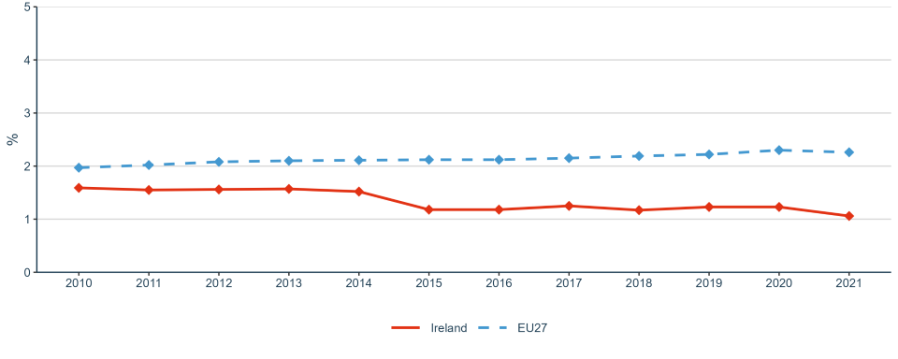
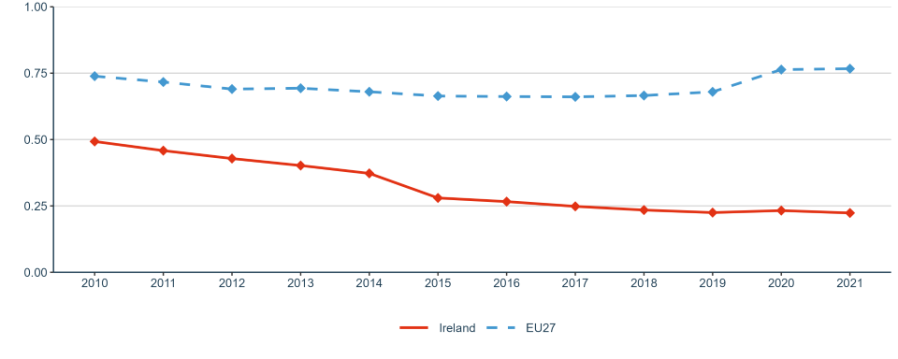
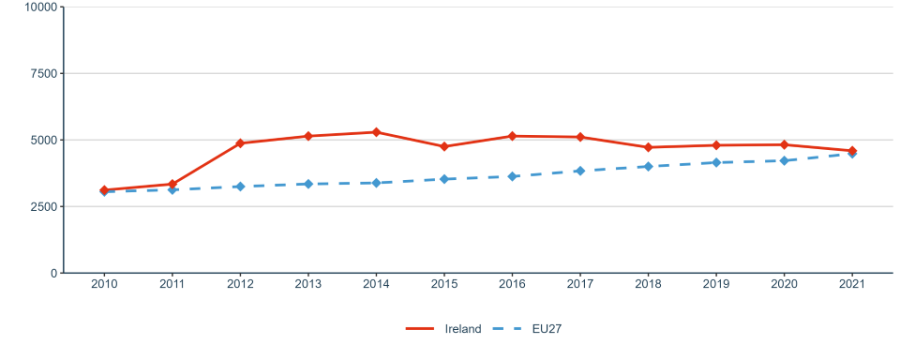

Priority 1: Deepening a truly functioning internal market for knowledge
Sub-priority 1.1: Open Science
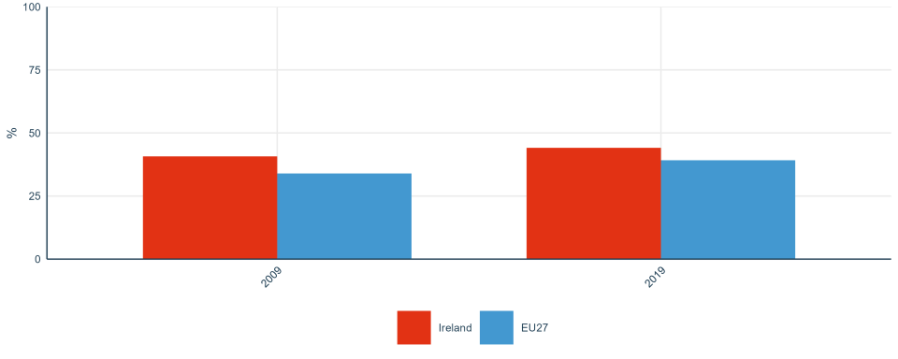
Sub-priority 1.2: Research infrastructures

Sub-priority 1.3: Gender equality, equal opportunities for all and inclusiveness
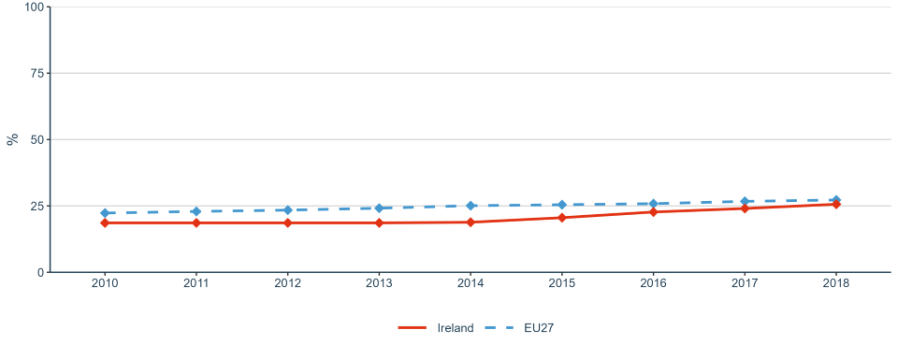
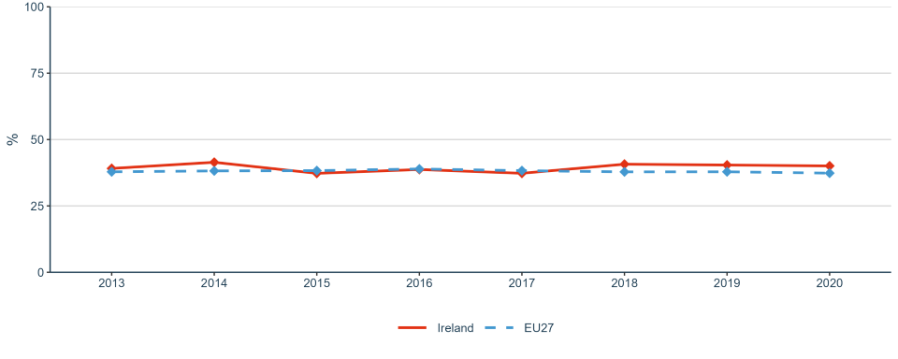
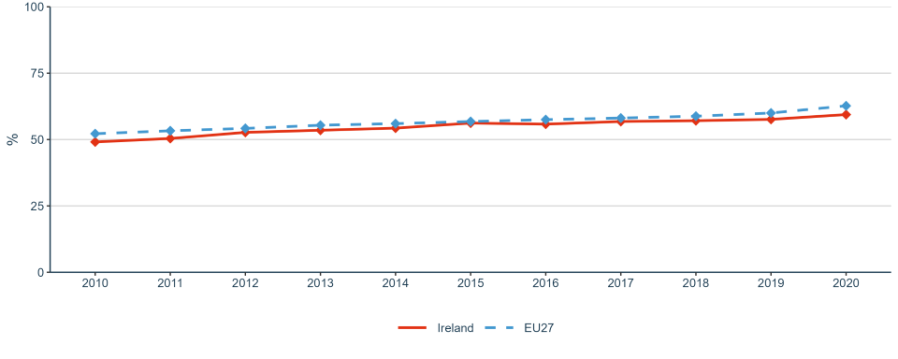
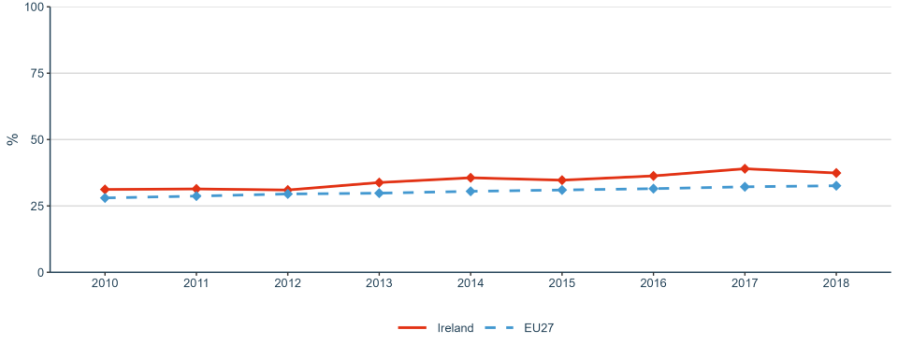
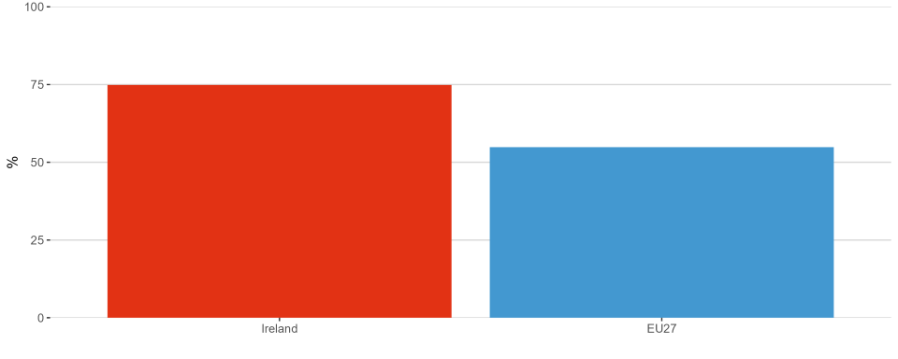
Sub-priority 1.4: Researchers’ careers and mobility and research assessment and reward systems
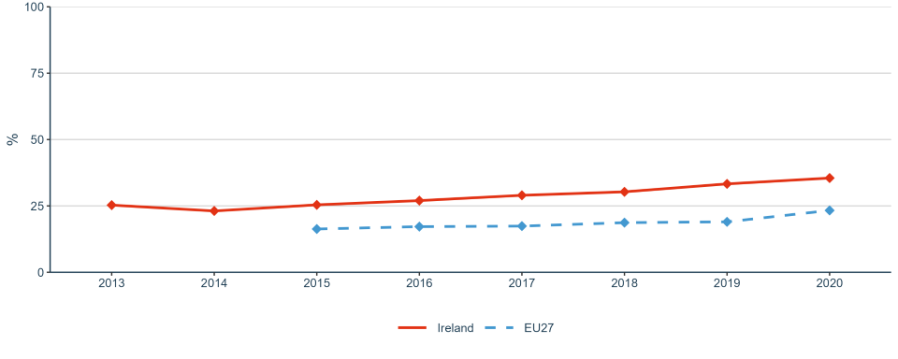

Sub-priority 1.5: Knowledge valorisation
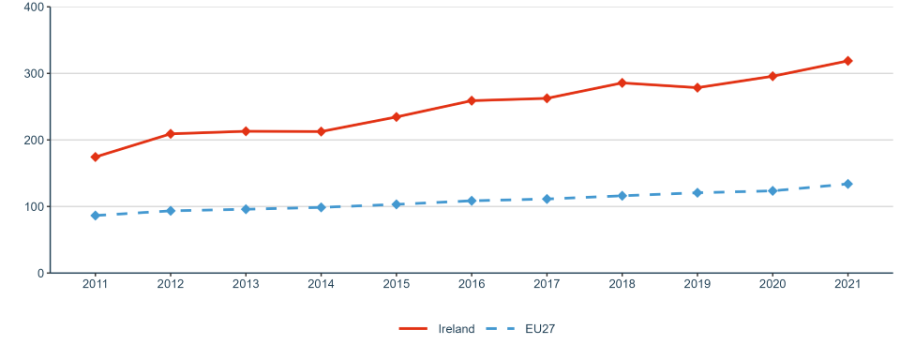
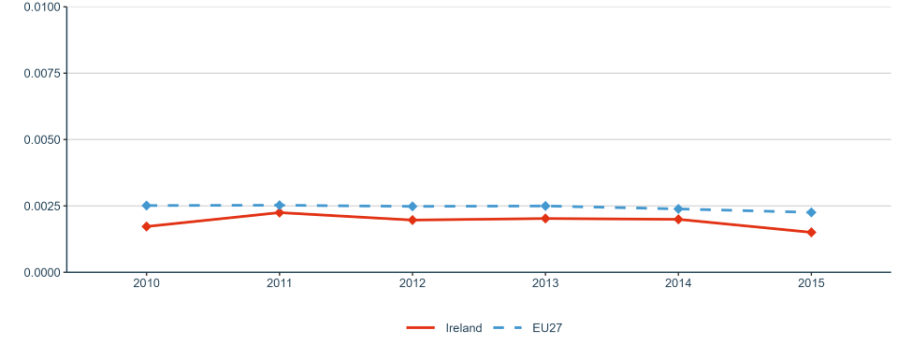
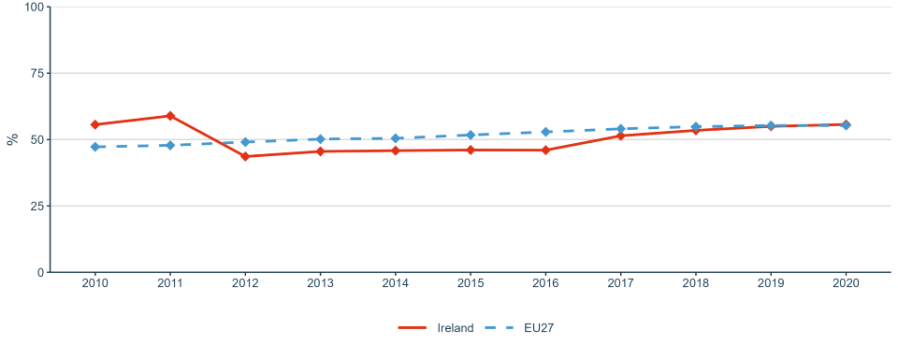
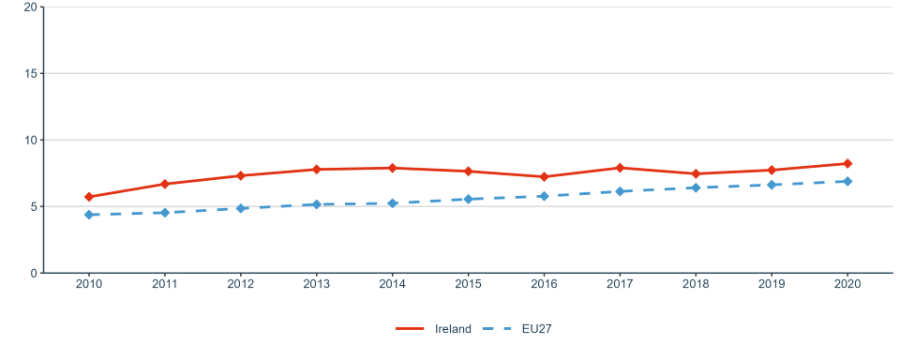
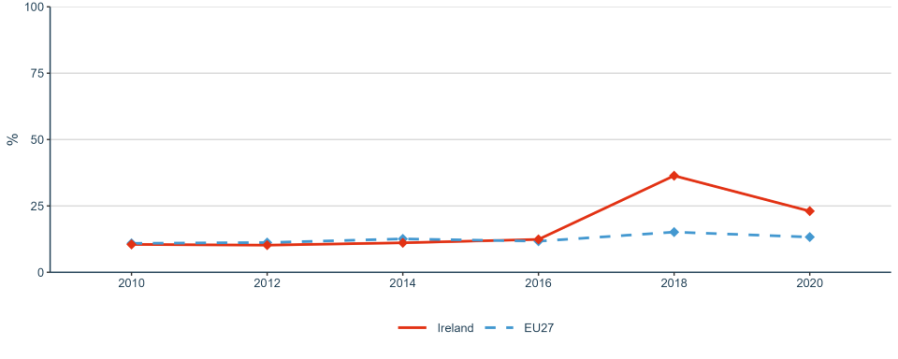
Sub-priority 1.6: Scientific leadership

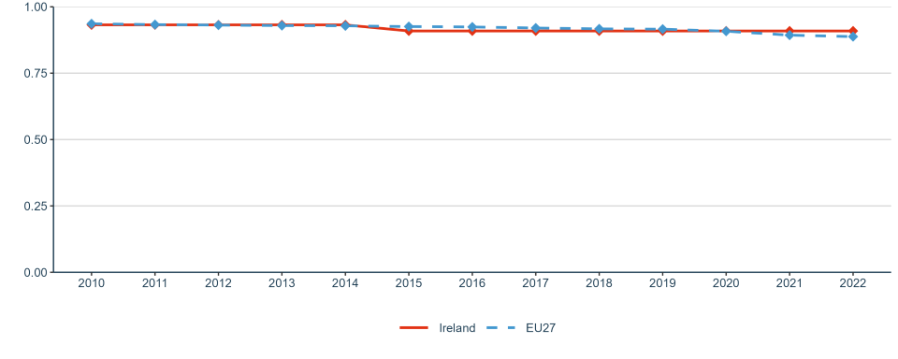
Sub-priority 1.7: Global engagement
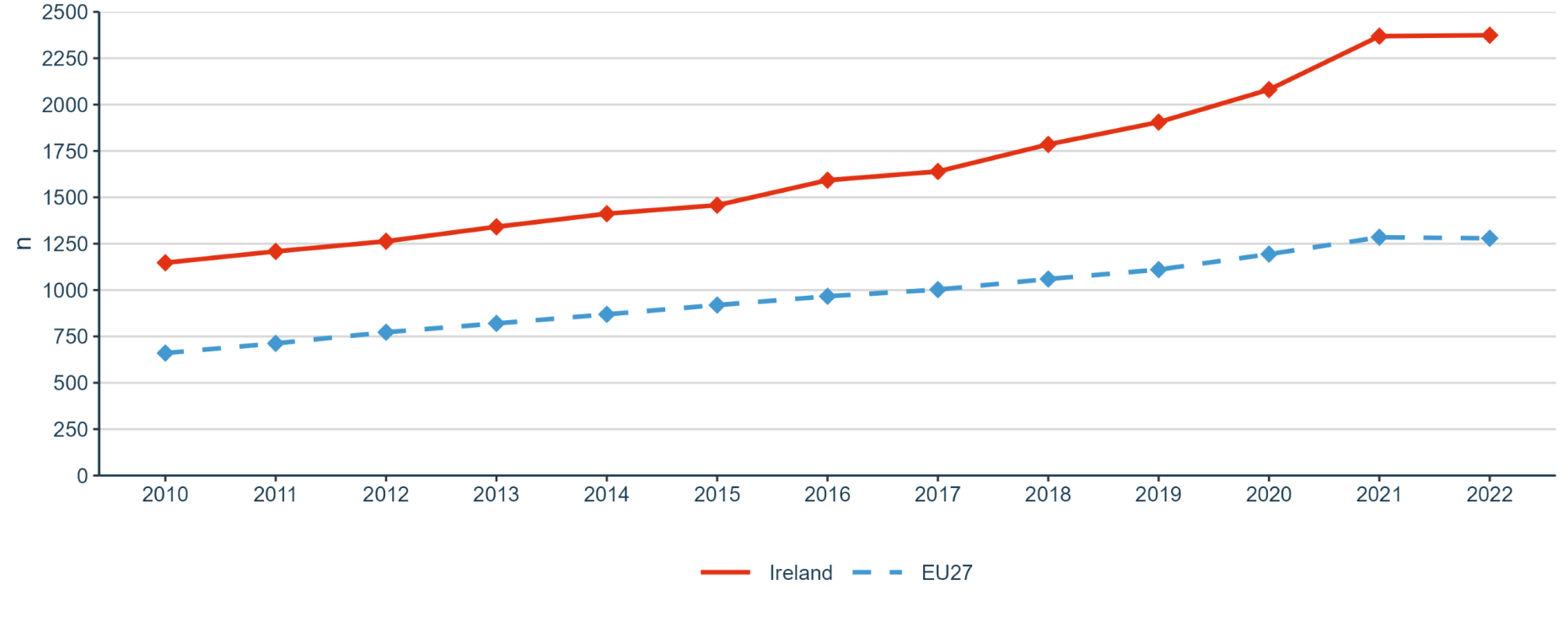
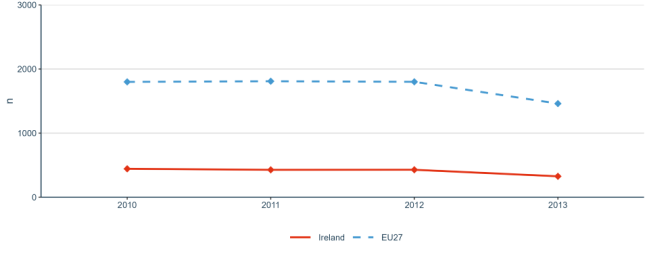
Priority 2: Taking up together the challenges posed by the twin green and digital transition and increasing society’s participation in the ERA
Sub-priority 2.1: Challenge-based ERA actions

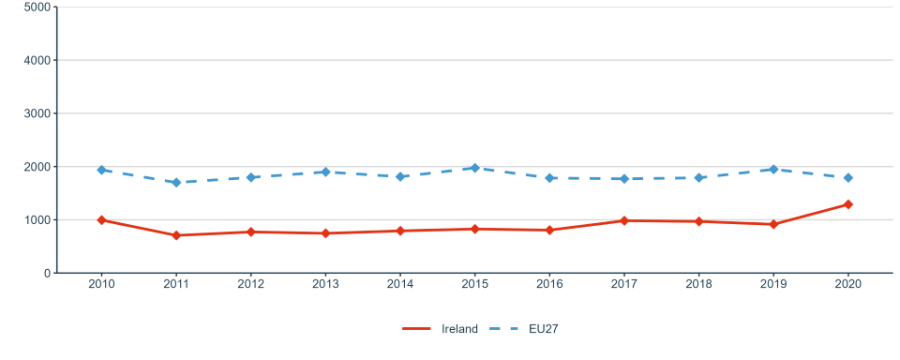


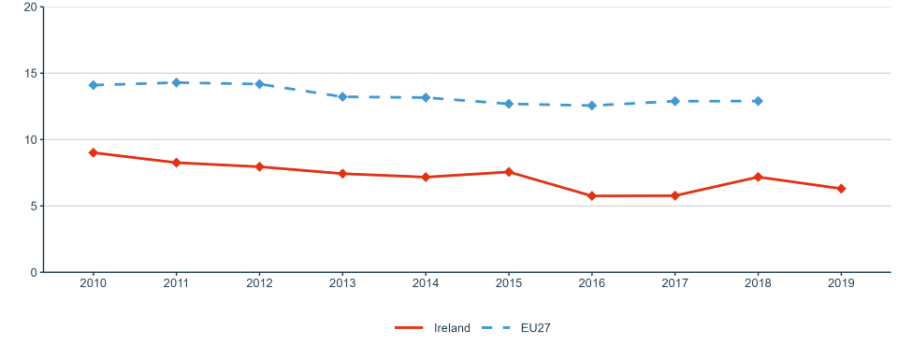
Sub-priority 2.2: Synergies with education and the European Skills Agenda

Sub-priority 2.3: Synergies with sectorial policies and industrial policy, in order to boost innovation ecosystems

Sub-priority 2.4: An active citizen and societal engagement in R&I in all its dimensions
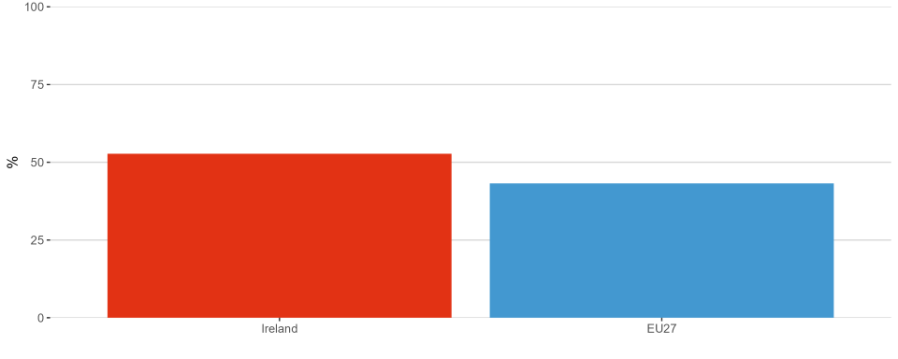
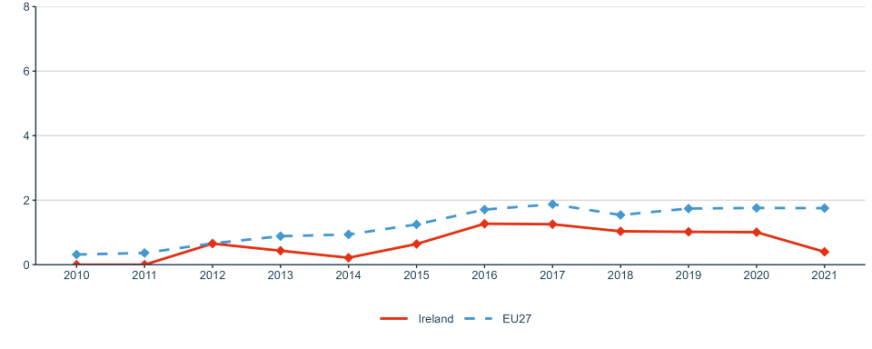
Priority 3: Amplifying access to research and innovation excellence across the Union
Sub-priority 3.1: More investments and reforms in countries and regions with lower R&I performance
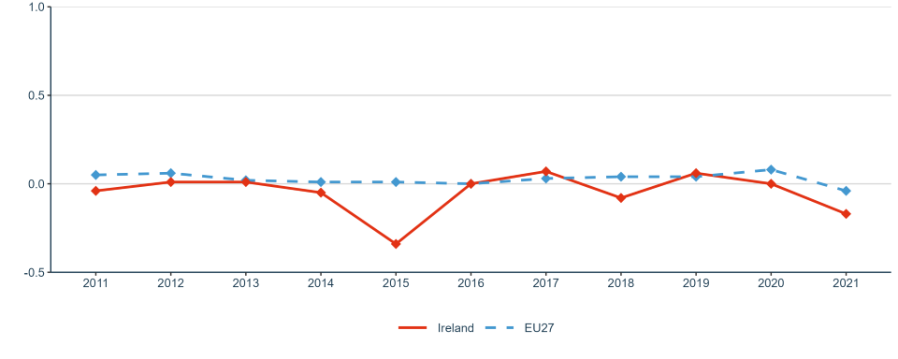
Priority 4: Advancing concerted research and innovation investments and reforms
Sub-priority 4.1: Coordination of R&I investments

